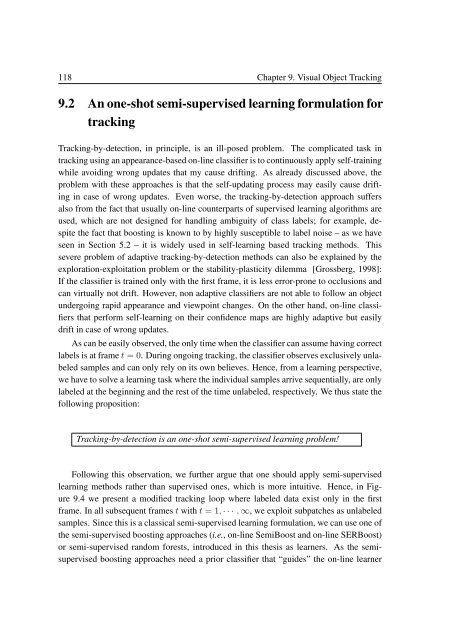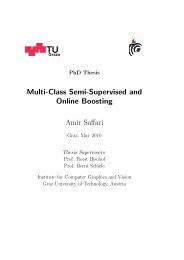PhD Thesis Semi-Supervised Ensemble Methods for Computer Vision
PhD Thesis Semi-Supervised Ensemble Methods for Computer Vision
PhD Thesis Semi-Supervised Ensemble Methods for Computer Vision
You also want an ePaper? Increase the reach of your titles
YUMPU automatically turns print PDFs into web optimized ePapers that Google loves.
118 Chapter 9. Visual Object Tracking<br />
9.2 An one-shot semi-supervised learning <strong>for</strong>mulation <strong>for</strong><br />
tracking<br />
Tracking-by-detection, in principle, is an ill-posed problem. The complicated task in<br />
tracking using an appearance-based on-line classifier is to continuously apply self-training<br />
while avoiding wrong updates that my cause drifting. As already discussed above, the<br />
problem with these approaches is that the self-updating process may easily cause drifting<br />
in case of wrong updates. Even worse, the tracking-by-detection approach suffers<br />
also from the fact that usually on-line counterparts of supervised learning algorithms are<br />
used, which are not designed <strong>for</strong> handling ambiguity of class labels; <strong>for</strong> example, despite<br />
the fact that boosting is known to by highly susceptible to label noise – as we have<br />
seen in Section 5.2 – it is widely used in self-learning based tracking methods. This<br />
severe problem of adaptive tracking-by-detection methods can also be explained by the<br />
exploration-exploitation problem or the stability-plasticity dilemma [Grossberg, 1998]:<br />
If the classifier is trained only with the first frame, it is less error-prone to occlusions and<br />
can virtually not drift. However, non adaptive classifiers are not able to follow an object<br />
undergoing rapid appearance and viewpoint changes. On the other hand, on-line classifiers<br />
that per<strong>for</strong>m self-learning on their confidence maps are highly adaptive but easily<br />
drift in case of wrong updates.<br />
As can be easily observed, the only time when the classifier can assume having correct<br />
labels is at frame t = 0. During ongoing tracking, the classifier observes exclusively unlabeled<br />
samples and can only rely on its own believes. Hence, from a learning perspective,<br />
we have to solve a learning task where the individual samples arrive sequentially, are only<br />
labeled at the beginning and the rest of the time unlabeled, respectively. We thus state the<br />
following proposition:<br />
Tracking-by-detection is an one-shot semi-supervised learning problem!<br />
Following this observation, we further argue that one should apply semi-supervised<br />
learning methods rather than supervised ones, which is more intuitive. Hence, in Figure<br />
9.4 we present a modified tracking loop where labeled data exist only in the first<br />
frame. In all subsequent frames t with t = 1, · · · , ∞, we exploit subpatches as unlabeled<br />
samples. Since this is a classical semi-supervised learning <strong>for</strong>mulation, we can use one of<br />
the semi-supervised boosting approaches (i.e., on-line <strong>Semi</strong>Boost and on-line SERBoost)<br />
or semi-supervised random <strong>for</strong>ests, introduced in this thesis as learners. As the semisupervised<br />
boosting approaches need a prior classifier that “guides” the on-line learner



